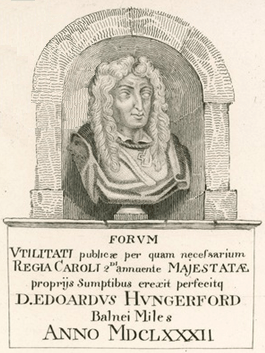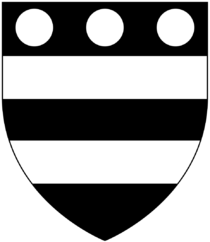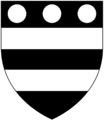Edward Hungerford (spendthrift) facts for kids

Sir Edward Hungerford, a Knight of the Bath (born October 20, 1632 – died 1711), was an English politician. He served in the House of Commons, which is like a part of today's Parliament, for many years between 1659 and 1702. Sir Edward was known for spending a lot of money. He sold many of his family's large estates, including their main home at Farleigh Hungerford, to pay for his very expensive lifestyle. He also started Hungerford Market in Charing Cross, London, as a business project.
Contents
Early Life and Family Background
Sir Edward Hungerford was born in 1632. His father was Anthony Hungerford, and his mother was Rachel Jones. He was baptized in Black Bourton, Oxfordshire. His father was a supporter of the King during the English Civil War. Edward studied at Queen's College, Oxford, in 1649. When his father passed away in 1657, Edward inherited the family's properties.
Political Career in Parliament
In 1658, Edward Hungerford became a Member of Parliament (MP) for Chippenham. He was elected again for Chippenham in 1660. On April 23, 1661, he was made a Knight of the Bath when King Charles II was crowned. This was a special honor.
He was elected for Chippenham again in 1661. Later, he was re-elected in 1661 and in both elections of 1679. In 1680, he asked for Parliament to meet. Because he opposed King Charles II's court, he was removed from his local leadership role in 1681.
Moving to London and Later Elections
In 1681, Sir Edward moved to Spring Gardens in Whitehall, London. He was elected MP for Chippenham again that same year. In 1683, his home at Farleigh Castle was searched. This happened because of suspicions related to a political plot called the Rye House Plot. He continued his political career, serving as MP for New Shoreham in 1685, 1688, and 1690. He then represented Steyning in 1695, 1698, 1700, and 1702.
Business Ventures and Spending Habits
Sir Edward Hungerford was known for supporting archery. He was a leader in the Regiment of Archers in 1661 and 1682. However, he was most famous for spending money very carelessly. It is said that he sold about thirty of his family's large estates.
Founding Hungerford Market
To try and improve his finances, he got permission in 1679 to open a market. This market would be held on Mondays, Wednesdays, and Saturdays. It was built on the land where his family's London home, Hungerford House, once stood. That house had been destroyed by a fire in 1669.
In 1682, a market building was put up. It was likely designed by the famous architect Sir Christopher Wren. A statue of Sir Edward was placed on the front of the building. It had a message saying that he built the market with the King's approval. In 1685, Sir Stephen Fox and Sir Christopher Wren bought the market. They then collected the fees from people using it. The market building was rebuilt in 1833. It was removed in 1860 to make way for Charing Cross railway station.
Selling Farleigh Castle
In 1686, Sir Edward sold his family's main home, Farleigh Castle, for a large sum of money. This sale ended centuries of ownership by the Hungerford family. The castle changed hands a few times after that.
Family Life and Marriages
Sir Edward Hungerford was married three times during his life.
First Marriage
His first marriage was before 1658 to Jane Hele. She passed away in 1664 and was buried at Farleigh. They had one son, Edward, who died in 1689. This son married Lady Alathea Compton when he was 19 years old. Sir Edward and Jane also had two daughters: Frances and Rachel. Rachel married Clotworthy Skeffington in 1684. When Rachel died in 1732, she left portraits of her father and other family members to her eldest son.
Later Marriages
His second marriage was in 1666 to Jane Culme. She lived until 1674. His third marriage was in 1679 to Jane Gerard. Neither of these later marriages had any children.
Later Years and Death
In his old age, it is said that Sir Edward Hungerford faced financial difficulties. He passed away in 1711. He was buried in the church of St. Martin's-in-the-Fields in London. With Sir Edward's death, the main story of the Hungerford family of Farleigh came to an end.
Images for kids
-
Drawing c.1832 of bust of Sir Edward Hungerford formerly in Hungerford Market.






